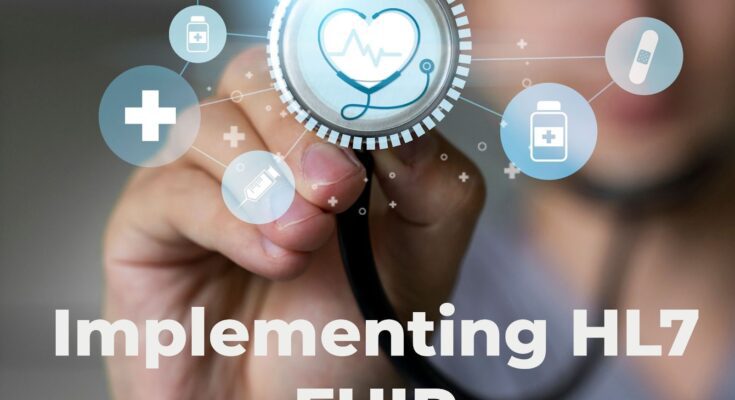Introduction:
The journey of implementing HL7 FHIR (Fast Healthcare Interoperability Resources) is both thrilling and daunting, rich with potential for transforming healthcare delivery. As the digital landscape continues to evolve, the interoperability challenges facing health systems demand smart strategies and innovative solutions. Embracing FHIR doesn’t merely signify a technical upgrade; it’s an invitation to rethink collaboration across providers, patients, and payers.
Understanding the nuances of FHIR’s resource-based architecture opens doors to more streamlined data exchange, paving the way for personalized patient care. HL7 Training Organizations that approach their deployment with agility can harness insights from ongoing interactions to inform future enhancements. In this rapidly changing environment, learning from early adopters’ experiences can provide valuable guidance in navigating potential pitfalls and maximizing benefits. Get ready to embark on a transformative journey where connectivity leads to better outcomes for all stakeholders in healthcare!
Understanding FHIR Basics
At its core, FHIR (Fast Healthcare Interoperability Resources) redefines how healthcare data is shared, promoting an adaptable and user-friendly approach to interoperability. Unlike prior standards which often relied on complex messaging formats, FHIR utilizes a resource-based framework that simplifies data exchange through modular components—each representing key health concepts such as patients, medications, or clinical observations. This granular methodology not only enhances the clarity of information but also fosters the development of innovative applications tailored to meet specific healthcare needs.
A significant advantage of FHIR lies in its ability to incorporate modern web technologies such as RESTful APIs and JSON/XML formats. This integration enables developers to create responsive applications that can interact seamlessly with electronic health records (EHRs) and other systems in real time. Moreover, FHIR supports patient engagement by allowing individuals greater access to their own health information through mobile apps or portals—empowering them to take charge of their health decisions more effectively. As organizations embark on deploying FHIR solutions, understanding these foundational concepts becomes essential for unlocking the full potential of interoperable healthcare services while ultimately improving care delivery outcomes.
Assessing Organizational Readiness
Assessing organizational readiness is crucial before embarking on the implementation of HL7 FHIR. It entails evaluating current infrastructure, identifying gaps in technological capabilities, and ensuring that team members are well-versed in FHIR standards. Engaging stakeholders early—from IT personnel to clinical practitioners—encourages buy-in and enriches the assessment process by incorporating diverse perspectives.
Moreover, organizations should benchmark against industry best practices to gauge their preparedness levels. This involves not only examining technological readiness but also considering workflow adaptability and staff training needs. Conducting mock scenarios can reveal potential barriers, allowing teams to address issues proactively. Ultimately, a thorough readiness evaluation sets the stage for seamless integration and paves the way for enhanced patient data interoperability.
Defining Project Scope and Objectives
Defining project scope and objectives is a critical first step in successfully implementing HL7 FHIR, as it sets the foundation for every subsequent phase of the deployment. A clearly articulated scope not only delineates what will be delivered but also highlights what falls outside that deliverable realm. Engaging stakeholders early in this process helps to harness diverse perspectives, which can uncover unique use cases and requirements that might otherwise go unnoticed. By collaboratively establishing clear objectives—such as improving interoperability or enhancing patient data accessibility—you create a collective vision that aligns with the overall goals of your organization.
Moreover, articulating specific, measurable objectives fosters accountability throughout the implementation journey. Instead of vague aspirations, establishing concrete targets allows teams to track progress effectively and make necessary adjustments along the way. Consider integrating metrics like reduced data retrieval times or increased user satisfaction scores; they serve as tangible indicators of success and help maintain momentum among team members. When scope and objectives are well-defined from the onset, organizations can navigate complexities more confidently, ensuring that their FHIR implementation not only meets immediate needs but also lays the groundwork for future innovations in health information exchange.
Developing a Project Plan
A well-structured project plan is the backbone of a successful HL7 FHIR deployment. Begin by defining clear objectives and key performance indicators (KPIs) to measure progress. Engaging stakeholders early ensures you gather valuable insights and foster collaboration, crucial for navigating complex healthcare environments.
Next, outline your timeline with realistic milestones that account for potential challenges like data migration or interoperability issues. Utilize agile methodologies to adapt your approach as necessary—this flexibility can be pivotal in addressing unforeseen roadblocks. Lastly, allocate resources intelligently; skilled personnel on both tech and clinical sides can bridge the gap between IT solutions and practical implementations, driving overall project success.
Choosing the Right FHIR Implementation Approach
When selecting a FHIR implementation approach, consider the unique characteristics of your organization and its interoperability needs. A tailored method that harmonizes with existing workflows can facilitate smoother integration and enhance stakeholder engagement. Opt for a phased implementation if resources are limited; this allows you to iteratively test features while gathering user feedback, ensuring adjustments are made before full deployment.
Alternatively, a big bang approach may be suitable for organizations ready to fully embrace change in one swift move. Whichever path you choose, prioritize strong governance and collaboration among diverse teams to leverage their expertise. This alignment not only fosters buy-in but also accelerates innovation and maximizes the potential of FHIR across systems.
Designing and Configuring FHIR Resources
Designing and configuring FHIR resources is a pivotal step in ensuring interoperability within healthcare systems. Start by thoroughly understanding the clinical domains your application aims to address; tailoring resources such as Patient, Encounter, or Observation to fit specific use cases fosters relevance and efficiency. Utilize the extensibility of FHIR to add custom elements that reflect your organization’s unique requirements while adhering to standard definitions.
Collaboration with stakeholders—including clinicians, data architects, and end-users—can illuminate practical nuances during resource design. Leverage tools like Forge or Simplifier to prototype and validate configurations early on. By simulating real-world scenarios through testing, you can identify potential pain points and refine resource interactions before going live. This proactive approach not only optimizes performance but enhances user acceptance across the board.
Developing and Testing FHIR Interfaces
Developing and testing FHIR interfaces demands a meticulous approach to ensure seamless interoperability across healthcare systems. Start by understanding the specific requirements of your organization and stakeholders; this ensures that your interface meets both functional needs and regulatory compliance. Utilizing frameworks like SMART on FHIR can accelerate development, allowing for quick prototyping while adhering to best practices.
Testing should be systematic, employing automated tools alongside manual processes for thorough validation. Embrace the use of synthetic data during testing phases to mimic real-world scenarios without risking patient confidentiality. Incorporating user feedback early in the process allows you to make iterative improvements, driving a more user-centric design that enhances clinical workflows. Prioritize collaboration among developers, testers, and end-users—this fosters a culture of innovation essential for successful deployment in an ever-evolving landscape.
Post-Deployment Review and Optimization
Post-deployment review and optimization are critical to ensuring that your HL7 FHIR implementation delivers sustained value. Start by gathering feedback from end-users and stakeholders, focusing on their experiences with data exchange efficiency and usability. This firsthand insight often reveals unexpected challenges or opportunities for enhancement.
Utilize analytics tools to monitor performance metrics, such as response times and error rates. Identifying trends in user behavior can guide targeted improvements—whether that’s refining APIs or enhancing documentation. Remember, the goal is not just to maintain functionality but to evolve your system continuously, adapting to emerging healthcare needs and technologies while fostering a culture of agility within your team. Embrace these insights as a roadmap for future adaptations, ensuring your organization remains at the forefront of health informatics innovation.



